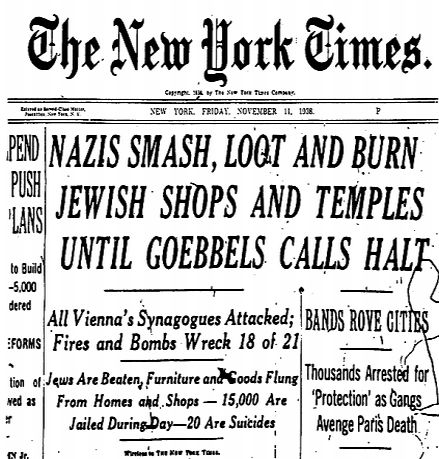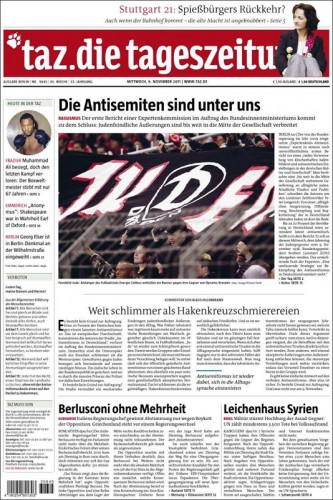„der Tod ist ein Meister aus Deutschland sein Auge ist blau er trifft dich mit bleierner Kugel er trifft dich genau"(Death is a Master from Germany his eye is blue He shoots you with shot made of lead he shoots you level and true)
From "Todesfuge" ("Death Fugue") by Paul Celan
The Berlin alternative daily, Die Tageszeitung marked 9 Nov 2011-- the 73rd anniversary of Kristallnacht -- with three items on anti-Semitism in Germany: a front page splash, a news analysis piece on page 5, and an op-ed piece on page 14.
Founded in West Berlin in 1979 Die Taz is Germany's newspaper for the "serious" Left -- progressive socialists, feminists, ecologists and pacifists. While its circulation runs to about 60,000 its influence is far greater due to its prominence among the chattering classes (a phrase coined by Matthew Arnold).
The front page story (the one next to the photo of boxer Joe Frazier) entitled "The anti-Semites are among us" reports:
that an unpublished first report by a [government commissioned] Expert Committee on anti-Semitism found that [negative] Jewish stereotypes and anti-Semitic attitudes were deeply rooted in German culture and society ... the mainstream of society had become used to anti-Jewish tirades ... and there was an everyday exclusion, defamation, insult and boycott of Jews living in Germany. ... up to 20 percent of the population in Germany was at least latently anti-Semitic, the report found.
The experts sobering conclusion was that "a comprehensive strategy to combat anti-Semitism in Germany does not exist."
An editorial entitled "Far worse than swastika graffiti" argued that while swastikas can be washed away, the prejudices that motivate anti-Semitic hate speech were not as easily purged. When hate speech becomes acceptable it reinforces "stereotypes even further, so that the prejudices of the individual becomes the norm for a group."
There is no simple answer to the verbal anti-Semitism [Die Taz argued]. But one thing is certain: There is cause for excitement. And not only on Nov 9. Anti-semitism is back again and is settling down into everyday language.
The inside news-analysis story entitled "Schoolyard epithet - 'Jude' (Jew)" developed the front page story reporting that:
today anti-Semitism can be observed even beyond the open Jew-hating right-wing extremist milieu: in schools and football clubs, at the volunteer fire department, in the letters columns of newspapers, in comments posted on social networking sites, but also in churches and among some leftists and globalization critics, and among immigrants.
 The schoolyard taunt "Jew" had "almost become commonplace in many places" while at German soccer games Jewish team members and their families in the stands were openly taunted.
The schoolyard taunt "Jew" had "almost become commonplace in many places" while at German soccer games Jewish team members and their families in the stands were openly taunted.
"Sentences like 'Jews belong in the gas chamber', 'Auschwitz is back" and "Synagogues must burn' in the regional competitions are at no rarity," says the report.
School classes that dealt with anti-Semitism focused exclusively on the Nazi period, the article found, giving students the impression that Jew-hatred was "exclusively attributable to the Nazi phenomenon, which appeared from nowhere in 1933 and then disappeared in 1945." The newspaper reported that in addition to traditional right wing anti-Semitism in Germany, the new current of anti-Semitism arose in part from responses to the Middle East conflict and the left's critique of capitalism with its polemics against financiers and greedy Wall Street bankers.
This is a great story and I applaud Die Taz for giving it such prominence in yesterday's issue. November 9 marks a number of prominent events in German history: the 1918 sailor's mutiny that precipitated the end of World War I, Hitler's 1923 Beer Hall Putsch, and Kristallnacht. On the night of 9-10 November 1938 the Nazi regime moved away from its "legal" process of depriving Jews of their rights through restrictive laws towards the open violence of an officially sanctioned pogrom. Over 1500 synagogues were burned, 30,000 Jewish men and boys were arrested and taken to Dachau and other concentration camps, approximately 100 Jews were murdered and thousands of Jewish owned businesses were ransacked by the SA, SS and Nazi party activists.
Leading with an anti-Semitism story on the anniversary was a great editorial decision by Die Taz. However, there is a religion hole in this story. While Die Taz lays out all the pieces that fit together in the reemergence of anti-Semitism -- right-wing Jew-haters, left-wing anti-capitalist polemicists, anti-Israel feeling -- it tip-toes around the final, and most important component: Islam. To lump the fire brigade and churches with the Muslim immigrant community as undifferentiated sources of the new anti-Semitism is disengenous indeed.
Forward, the Jerusalem Post and a host of publications have examined the part played by Islam in the resurgent European anti-Semitism, and its omission hurts this story.
However, I may need to explain for a non-German audience the significance of Die Taz bringing up the issue of anti-Semitism -- and why I am happy with so much of what they have done. In a few broad brush strokes let me give some context.
On 10 November 1988 the two Germanys convened special sessions of their parliaments to mark the 50th anniversary of Kristallnacht, the "night of broken glass".
In East Berlin the Volkskammer was addressed by its president, Horst Sindermann, a Communist Party leader who spent almost a decade in Nazi prison camps. The focus of his speech to the assembly was that the DDR had been a bulwark against fascism, which itself was the highest expression of capitalism's destructive nature. Historically there had been little public discussion of anti-Semitism in the DDR as it saw the persecution of the Jews was one of the many evils of the Nazi era.
 In Bonn, the Bundestag held its first official commemoration of Kristallnacht. The ceremony began with the reading of the "Death Fugue," a poem about the Holocaust by Paul Celan -- a Romanian Jew who survived the camps. The chairman of the Bundestag, CDU leader Phillip Jenninger then rose and read a speech the New York Times subsequently printed on page A5 in its 12 Nov 1988 edition. It began with:
In Bonn, the Bundestag held its first official commemoration of Kristallnacht. The ceremony began with the reading of the "Death Fugue," a poem about the Holocaust by Paul Celan -- a Romanian Jew who survived the camps. The chairman of the Bundestag, CDU leader Phillip Jenninger then rose and read a speech the New York Times subsequently printed on page A5 in its 12 Nov 1988 edition. It began with:
Today we have come together in the Bundestag ... because not the victims but we in whose midst the crimes took place have to remember and account for what we did; because we as Germans want to come to an understanding of our past and of its lessons for our present and future politics.
He examined the history and read extracts from official statements of the Nazi era to illustrate the beliefs and actions of the regime. But the speech caused an uproar the New York Times reported, prompting 50 left-wing deputies to walk out. Three days later he resigned and apologized for his "insensitive" words after critics charged that he had said the right things, but at the wrong place and time.
Conservatives deputies, some of whom were photographed holding their heads in their hands during the speech, stayed seated, but were unhappy. After two decades of avoiding the topic -- or claiming ignorance of the deeds done in secret by the SS --by the 1980's the Federal Republic had found that by accepting responsibility for the past, it could rejoin the world community.
The received view of Kristallnacht among Germans had been that the Nazis had committed the crimes, while Germany watched. Their sin was one of indifference. Jenninger's words forced Germany to remember that Germans were not only indifferent to the fate of the Jews, but they were complicit in segregating and expelling Jews from German society and in carrying out the Holocaust. German memory focused on the victims and found a national identity in response to their sufferings -- not to the evils done by the perpetrators.
The reasons offered for the left's walk out were confused and many deputies stated theirs was an emotional reaction. But the use of the word "we" -- admitting that all Germans were complicit in the crimes of the Nazi era and Jenninger's focusing on the perpetrators of the crimes was too much for the political leaders of the '68 Generation. Activists who had condemned the continuity between the Nazi past and the West German present, believing their rejection had purified them of the crimes of the Holocaust, refused to accept culpability for their country's anti-Semitic past.
It may have been fortuitous. It may have been unintentional. Or it may have been an editorial decision by the left wing newspaper to use the anniversary of Kristallnacht -- the one event of the Holocaust which no German then living could deny knowing -- to chastize the country for its slide back into evil was remarkable. Thank you Die Taz.
Now if only they weren't shy about confronting the Muslim roots of the new hate the story would have hit a home run.
Addendum: In response to readers' emails, here are some links to the topic of anti-Semitism in Europe and Islam. I also recommend two recent books: Walter Laquer's book The Changing Face of anti-Semitism: From Ancient Times to the Present Day(NY: OUP, 2006) and Raphael Israeli, Muslim anti-Semitism in Christian Europe: Elemental and Residual anti-Semitism (NY: Transaction Publishers, 2009). This is by no means an exhaustive list, but will help start your researches.

